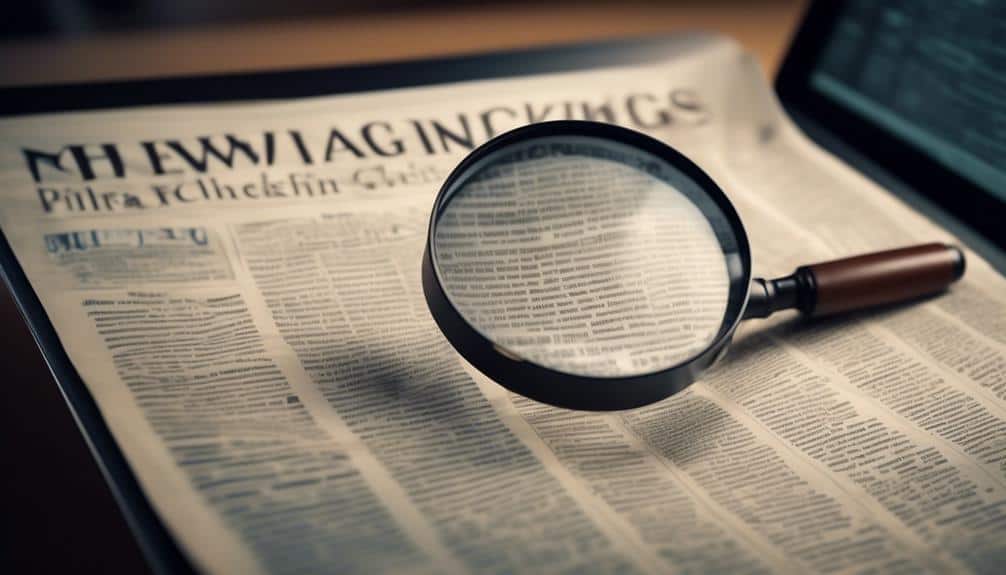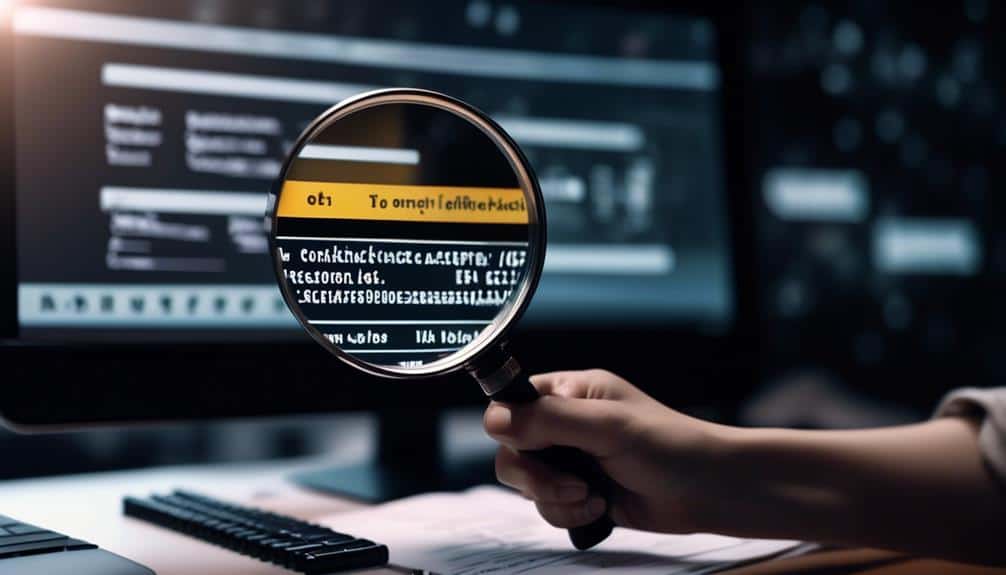The Art of Fact-Checking: Tools and Tips for Content Accuracy
When you come across an article with a startling statistic or a jaw-dropping claim, how often do you pause to question its accuracy?
The ability to distinguish between fact and fiction in today's digital landscape is more crucial than ever.
As you navigate through the vast sea of information online, wouldn't it be invaluable to have a set of reliable tools and expert tips at your disposal to ensure the content you encounter is indeed accurate?
Key Takeaways
- Utilizing reliable fact-checking tools such as ClaimReview Schema and Google Reverse Image Search enhances credibility.
- Incorporating systematic fact-checking approaches, including multiple source comparison and expert validation, ensures accuracy.
- Prioritizing thorough fact-checking processes and staying updated on new technologies improve efficiency and effectiveness.
- Engaging experts for peer review processes and real-time consultations strengthens content credibility and trustworthiness.
Importance of Fact-Checking

Fact-checking plays a crucial role in ensuring the accuracy and credibility of information presented in various forms of content. Research integrity is upheld through meticulous fact-checking processes that verify the validity of data, sources, and claims. By conducting thorough fact-checking, content creators can enhance the reliability of their work and build trust with their audience. Content validation is essential for maintaining the integrity of information shared in articles, reports, and other written materials.
When fact-checking is prioritized, errors and misinformation can be identified and corrected promptly, contributing to a higher standard of quality in published content. Upholding research integrity through fact-checking demonstrates a commitment to accuracy and accountability in the dissemination of information. With the increasing volume of content available online, the importance of fact-checking can't be overstated. By embracing rigorous fact-checking practices, content creators contribute to a culture of accuracy and reliability in the digital landscape.
Reliable Fact-Checking Tools
With the growing demand for accuracy and credibility in content creation, exploring reliable fact-checking tools becomes imperative for maintaining the integrity of information shared online.
In the quest for trustworthy information validation, utilizing advanced fact-checking software analysis can significantly enhance the accuracy of your content. Here are three reliable fact-checking tools that can aid you in ensuring the credibility of your work:
- ClaimReview Schema: This tool allows fact-checkers to markup their content with specific tags that search engines can use to identify fact-checked information. It helps in promoting factually accurate content online.
- Media Bias/Fact Check: This website offers a comprehensive database of media sources categorized by bias and reliability. It can assist in evaluating the credibility of news outlets and sources.
- Google Reverse Image Search: This feature helps verify the authenticity of images used in content by conducting a reverse search across the web for similar images, aiding in detecting potential misinformation.
Strategies for Cross-Verification

When fact-checking content for accuracy, it's vital to employ strategies for cross-verification. Utilize multiple source comparison to corroborate information and ensure its reliability.
Employ the data triangulation technique and seek verification through experts to strengthen the credibility of the content.
Multiple Source Comparison
To ensure the accuracy of content, regularly comparing information from multiple sources is essential for cross-verification. When engaging in multiple source comparison, consider the following:
- Source Comparison Techniques: Utilize different sources such as reputable websites, scholarly articles, and expert opinions to cross-verify information.
- Information Validation Methods: Employ fact-checking tools, consult primary sources, and verify data accuracy to ensure the reliability of the content.
- Corroborate Evidence: Look for consistency in facts, quotes, and statistics across various sources to validate the information's authenticity.
Data Triangulation Technique
Data triangulation, a robust method for cross-verifying information, involves comparing data from multiple sources to enhance accuracy and reliability. By utilizing this technique, you can strengthen the credibility of your content through data validation and credibility assessment.
When engaging in information authentication, evidence examination becomes essential to ensure the accuracy of your sources. This process allows you to identify inconsistencies or discrepancies among the data sets, leading to a more comprehensive understanding of the topic at hand.
Through data triangulation, you can uncover hidden patterns, confirm the validity of claims, and present a more well-rounded perspective to your audience. Embracing this method in your fact-checking endeavors can significantly enhance the quality and trustworthiness of your content.
Verification Through Experts
Utilizing expertise verification as a strategic cross-verification method enhances the credibility and accuracy of information presented in content. When seeking expert validation for your content, here are three key strategies to consider:
- Diverse Expertise: Engage experts from various fields related to the content to ensure comprehensive verification.
- Peer Review: Facilitate a peer review process where experts in the same field critically assess the accuracy and validity of the information presented.
- Real-Time Consultation: Establish a system for real-time consultation with experts to quickly verify complex or specialized information, ensuring up-to-date accuracy.
Fact-Checking Tips for Digital Content

When fact-checking digital content, it's crucial to prioritize source verification and cross-referencing for accuracy.
By ensuring the credibility of your sources and cross-referencing information from multiple reliable outlets, you can enhance the overall accuracy and credibility of your content.
These steps are essential in maintaining trust and integrity in the information you provide to your audience.
Source Verification Importance
Verifying the credibility of your sources is a crucial step in ensuring the accuracy of digital content. When it comes to source verification, consider the following:
- Trustworthiness Assessment: Evaluate the reputation and expertise of the source to gauge their reliability.
- Information Validation: Cross-reference the information provided by the source with other reputable sources to confirm its accuracy.
- Consistency Check: Ensure that the information aligns with established facts and logic to avoid spreading misinformation.
Cross-Referencing for Accuracy
To ensure the accuracy of your digital content, employ thorough cross-referencing techniques. In the fact-checking process, cross-referencing plays a crucial role in evidence validation. By comparing information from multiple credible sources, you can verify the accuracy and reliability of your content. Below is a table highlighting the significance of cross-referencing in ensuring factual integrity:
| Importance of Cross-Referencing | Benefits |
|---|---|
| Detecting misinformation | Ensures content credibility |
| Enhancing accuracy | Validates information |
| Identifying bias | Strengthens the reliability of content |
| Improving content quality | Builds trust with the audience |
Evaluating Sources Credibility
To ensure the accuracy and reliability of content, it's essential to critically evaluate the credibility of your information sources. When evaluating sources, consider the following factors:
- Bias Detection: Look for any signs of bias in the information provided. Bias can greatly affect the reliability of a source, so it's crucial to identify and account for any potential biases that may exist.
- Trustworthiness Assessment: Assess the trustworthiness of the sources by researching their reputation and track record. Reliable sources are transparent about their methods and provide evidence to support their claims.
- Consistency Check: Verify if the information provided by the source aligns with other reputable sources. Consistency among different sources increases the likelihood of accuracy.
Fact-Checking Best Practices

When fact-checking content, ensure to meticulously scrutinize sources for accuracy and reliability to uphold the integrity of the information presented. Incorporating robust fact-checking methods is paramount to maintaining content accuracy. Start by verifying information from multiple reputable sources to cross-reference details and confirm their validity. Utilize fact-checking tools and platforms to aid in the verification process, ensuring that the sources are credible and trustworthy.
Employ a systematic approach to fact-checking by organizing information logically and methodically. Develop a checklist of common fact-checking steps to ensure thoroughness and consistency in verifying the accuracy of content. Continuously update your fact-checking methods to stay abreast of new tools and technologies that can enhance the accuracy and efficiency of the process.
Frequently Asked Questions
How Can Fact-Checking Help Combat Misinformation and Fake News in Today's Digital Age?
Fact-checking empowers you to combat misinformation and fake news in today's digital age. By verifying information before sharing on social media, you can uphold accuracy and promote critical thinking in an era of rapid information dissemination.
Are There Any Legal Implications for Not Fact-Checking Content Before Publishing It?
Not fact-checking content before publishing may lead to legal consequences. Upholding journalistic ethics is crucial to avoid misinformation. Ensure accuracy to maintain credibility and trust. Take responsibility for the impact of your published work.
How Do Fact-Checkers Handle Situations Where There Are Conflicting Sources or Information?
When handling conflicting sources, fact-checkers face dilemmas. They sift through evidence, verify credibility, and analyze context. By cross-referencing, seeking expert opinions, and using critical thinking skills, they strive for accuracy in their content assessments.
What Are Some Common Pitfalls to Avoid When Fact-Checking Digital Content?
When fact-checking digital content, common mistakes include relying on a single source, overlooking context, and failing to verify images. Use verification techniques like reverse image search, cross-referencing sources, and analyzing metadata to ensure accuracy.
Enhance your fact-checking skills by honing critical thinking and refining source evaluation techniques. Navigate the information landscape adeptly, discerning fact from fiction. Stay vigilant, seek diverse perspectives, and verify information before sharing.
Conclusion
In conclusion, fact-checking is a crucial practice for ensuring the accuracy and credibility of content.
By utilizing reliable fact-checking tools, employing cross-verification strategies, and evaluating sources' credibility, you can uphold the integrity of your digital content.
Remember to adhere to fact-checking best practices to maintain a high standard of accuracy in your work.
Stay vigilant, thorough, and committed to the art of fact-checking to uphold the truth in all your content.








